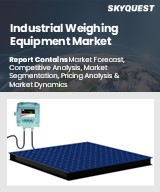
|
시장보고서
상품코드
1801982
산업용 계량 장비 시장 규모, 점유율, 성장 분석 : 제품 유형별, 용도별, 최종사용자별, 지역별 - 산업 예측(2025-2032년)Industrial Weighing Equipment Market Size, Share, and Growth Analysis, By Product Type (Bench Scales, Floor Scales), By Application (Manufacturing, Food and Beverage), By End User, By Region - Industry Forecast 2025-2032 |
||||||
세계의 산업용 계량 장비 시장 규모는 2023년에 25억 달러로 평가되며, 2024년 26억 2,000만 달러에서 2032년에는 37억 8,000만 달러로 성장하며, 예측 기간(2025-2032년)의 CAGR은 4.7%로 성장할 전망입니다.
세계 산업용 계량 장비 시장은 E-Commerce의 확대, 자동화 및 디지털 기술 도입 확대와 함께 제조 및 물류의 정밀성에 대한 요구가 높아지면서 크게 성장하고 있습니다. 이 장비는 재고 관리, 생산 계획, 자재 낭비를 최소화하는 데 중요한 역할을 합니다. 스마트 계량 시스템을 IoT, 인공지능, 머신러닝과 통합하여 업무 효율성과 정확성을 향상시킬 수 있습니다. 또한 규제 요건으로 인해 인증된 계량 솔루션에 대한 요구가 증가하고 있습니다. 또한 지속가능성과 에너지 효율에 대한 관심이 높아지면서 재료 손실을 줄이는 관행을 촉진하는 시장 역학이 형성되고 있습니다. AI, 블록체인, 가상현실 등의 혁신은 업계내 사용자 참여, 운영 프로세스, 교육 방법을 재정의하고 있습니다.
목차
서론
- 조사의 목적
- 조사 범위
- 정의
조사 방법
- 정보 조달
- 2차와 1차 데이터 방법
- 시장 규모 예측
- 시장의 전제조건과 제한
개요
- 세계 시장 전망
- 공급과 수요 동향 분석
- 부문별 기회 분석
시장 역학과 전망
- 시장 개요
- 시장 규모
- 시장 역학
- 촉진요인과 기회
- 억제요인과 과제
- Porter의 산업 분석
주요 시장 인사이트
- 주요 성공 요인
- 경쟁의 정도
- 주요 투자 기회
- 시장 에코시스템
- 시장의 매력 지수(2024년)
- PESTEL 분석
- 거시경제 지표
- 밸류체인 분석
- 가격 분석
- 기술 분석
- 사례 연구
산업용 계량 장비 시장 규모 : 제품 유형별 & CAGR(2025-2032)
- 시장 개요
- 벤치 스케일
- 플로어 스케일
- 로드 셀
- 인디케이터와 컨트롤러
- 계량 소프트웨어
산업용 계량 장비 시장 규모 : 용도별 & CAGR(2025-2032)
- 시장 개요
- 제조업
- 식품 및 음료
- 화학제품
- 헬스케어
- 운송·물류
- 기타
산업용 계량 장비 시장 규모 : 최종사용자별 & CAGR(2025-2032)
- 시장 개요
- 산업용
- 상업용
- 기타
산업용 계량 장비 시장 규모 & CAGR(2025-2032)
- 북미
- 미국
- 캐나다
- 유럽
- 독일
- 스페인
- 프랑스
- 영국
- 이탈리아
- 기타 유럽 지역
- 아시아태평양
- 중국
- 인도
- 일본
- 한국
- 기타 아시아태평양
- 라틴아메리카
- 브라질
- 기타 라틴아메리카 지역
- 중동 및 아프리카
- GCC 국가
- 남아프리카공화국
- 기타 중동 및 아프리카
경쟁 정보
- 상위 5사의 비교
- 주요 기업의 시장 포지셔닝(2024년)
- 주요 시장 기업이 채택한 전략
- 최근 시장 동향
- 기업의 시장 점유율 분석(2024년)
- 주요 기업의 기업 개요
- 기업의 상세
- 제품 포트폴리오 분석
- 기업의 부문별 점유율 분석
- 매출의 전년대비 비교(2022-2024년)
주요 기업 개요
- Mettler Toledo
- Cardinal Scale Manufacturing Company
- Doran Scales, Inc.
- Fairbanks Scales Inc.
- Rice Lake Weighing Systems
- Ohaus Corporation
- Sartorius AG
- A&D Weighing
- B-TEK Scales, LLC
- Adam Equipment Co. Ltd.
- Bilwinco AS
- Bizerba SE & Co. KG
- Bonso Electronics International Inc.
- Dini Argeo S.r.l.
- Esit Electronic Ltd.
결론과 제안
KSA 25.09.05Global Industrial Weighing Equipment Market size was valued at USD 2.5 billion in 2023 and is poised to grow from USD 2.62 billion in 2024 to USD 3.78 billion by 2032, growing at a CAGR of 4.7% during the forecast period (2025-2032).
The global industrial weighing equipment market is experiencing significant growth driven by an increased demand for precision in manufacturing and logistics, along with the expansion of e-commerce and greater adoption of automation and digital technologies. This equipment plays a vital role in inventory management, production planning, and minimizing material waste. The integration of smart weighing systems with IoT, artificial intelligence, and machine learning enhances operational efficiency and accuracy. Regulatory requirements have also heightened the need for certified weighing solutions. Additionally, a growing focus on sustainability and energy efficiency is shaping market dynamics by promoting practices that reduce material losses. Innovations such as AI, Blockchain, and virtual reality are redefining user engagement, operational processes, and training methods within the industry.
Top-down and bottom-up approaches were used to estimate and validate the size of the Global Industrial Weighing Equipment market and to estimate the size of various other dependent submarkets. The research methodology used to estimate the market size includes the following details: The key players in the market were identified through secondary research, and their market shares in the respective regions were determined through primary and secondary research. This entire procedure includes the study of the annual and financial reports of the top market players and extensive interviews for key insights from industry leaders such as CEOs, VPs, directors, and marketing executives. All percentage shares split, and breakdowns were determined using secondary sources and verified through Primary sources. All possible parameters that affect the markets covered in this research study have been accounted for, viewed in extensive detail, verified through primary research, and analyzed to get the final quantitative and qualitative data.
Global Industrial Weighing Equipment Market Segments Analysis
Global Industrial Weighing Equipment Market is segmented by Product Type, Application, End User and region. Based on Product Type, the market is segmented into Bench Scales, Floor Scales, Load Cells, Indicators and Controllers and Weighing Software. Based on Application, the market is segmented into Manufacturing, Food and Beverage, Chemical, Healthcare, Transportation and Logistics and Others. Based on End User, the market is segmented into Industrial, Commercial and Others. Based on region, the market is segmented into North America, Europe, Asia Pacific, Latin America and Middle East & Africa.
Driver of the Global Industrial Weighing Equipment Market
The Global Industrial Weighing Equipment market is being significantly driven by the increasing embrace of smart manufacturing and Industry 4.0. Advanced automated weighing systems, which integrate digital sensors, software analytics, and IoT capabilities, are gaining popularity due to their ability to facilitate real-time data monitoring and streamline workflow management. Additionally, the growing trend towards mass customization and small batch production across various sectors calls for adaptable and versatile weighing solutions to meet diverse operational needs. As manufacturing output escalates and industries transition to automated processes, the role of weighing equipment in improving operational precision becomes increasingly vital.
Restraints in the Global Industrial Weighing Equipment Market
The substantial initial investment and continuous maintenance expenses pose significant challenges for small and medium-sized enterprises looking to adopt advanced weighing solutions. Such financial barriers are exacerbated by the necessity for bespoke modifications to align with specific industry needs, particularly in manufacturing and logistics software integration. In addition to these costs, advanced systems often demand regular software updates, sensor replacements, and training for operators, all of which contribute to an increased financial strain. Consequently, these factors make it difficult for smaller businesses to embrace the advanced technologies available in the industrial weighing equipment market.
Market Trends of the Global Industrial Weighing Equipment Market
The global industrial weighing equipment market is witnessing a significant trend towards the integration of Internet of Things (IoT) and smart technologies, revolutionizing the operation and functionality of weighing systems across various industries. This shift enhances the accuracy and efficiency of measurements, as advanced sensors and wireless communication capabilities facilitate real-time data transmission to cloud-based platforms. Consequently, businesses are increasingly adopting these smart weighing solutions to optimize inventory management, improve operational workflows, and enhance decision-making processes. The demand for enhanced connectivity and automation in industrial applications continues to drive innovation and investment in smart weighing technologies, reflecting a broader trend towards digital transformation in manufacturing and logistics.
Table of Contents
Introduction
- Objectives of the Study
- Scope of the Report
- Definitions
Research Methodology
- Information Procurement
- Secondary & Primary Data Methods
- Market Size Estimation
- Market Assumptions & Limitations
Executive Summary
- Global Market Outlook
- Supply & Demand Trend Analysis
- Segmental Opportunity Analysis
Market Dynamics & Outlook
- Market Overview
- Market Size
- Market Dynamics
- Drivers & Opportunities
- Restraints & Challenges
- Porters Analysis
- Competitive rivalry
- Threat of substitute
- Bargaining power of buyers
- Threat of new entrants
- Bargaining power of suppliers
Key Market Insights
- Key Success Factors
- Degree of Competition
- Top Investment Pockets
- Market Ecosystem
- Market Attractiveness Index, 2024
- PESTEL Analysis
- Macro-Economic Indicators
- Value Chain Analysis
- Pricing Analysis
- Technology Analysis
- Case Studies
Global Industrial Weighing Equipment Market Size by Product Type & CAGR (2025-2032)
- Market Overview
- Bench Scales
- Floor Scales
- Load Cells
- Indicators and Controllers
- Weighing Software
Global Industrial Weighing Equipment Market Size by Application & CAGR (2025-2032)
- Market Overview
- Manufacturing
- Food and Beverage
- Chemical
- Healthcare
- Transportation and Logistics
- Others
Global Industrial Weighing Equipment Market Size by End User & CAGR (2025-2032)
- Market Overview
- Industrial
- Commercial
- Others
Global Industrial Weighing Equipment Market Size & CAGR (2025-2032)
- North America (Product Type, Application, End User)
- US
- Canada
- Europe (Product Type, Application, End User)
- Germany
- Spain
- France
- UK
- Italy
- Rest of Europe
- Asia Pacific (Product Type, Application, End User)
- China
- India
- Japan
- South Korea
- Rest of Asia-Pacific
- Latin America (Product Type, Application, End User)
- Brazil
- Rest of Latin America
- Middle East & Africa (Product Type, Application, End User)
- GCC Countries
- South Africa
- Rest of Middle East & Africa
Competitive Intelligence
- Top 5 Player Comparison
- Market Positioning of Key Players, 2024
- Strategies Adopted by Key Market Players
- Recent Developments in the Market
- Company Market Share Analysis, 2024
- Company Profiles of All Key Players
- Company Details
- Product Portfolio Analysis
- Company's Segmental Share Analysis
- Revenue Y-O-Y Comparison (2022-2024)
Key Company Profiles
- Mettler Toledo
- Company Overview
- Business Segment Overview
- Financial Updates
- Key Developments
- Cardinal Scale Manufacturing Company
- Company Overview
- Business Segment Overview
- Financial Updates
- Key Developments
- Doran Scales, Inc.
- Company Overview
- Business Segment Overview
- Financial Updates
- Key Developments
- Fairbanks Scales Inc.
- Company Overview
- Business Segment Overview
- Financial Updates
- Key Developments
- Rice Lake Weighing Systems
- Company Overview
- Business Segment Overview
- Financial Updates
- Key Developments
- Ohaus Corporation
- Company Overview
- Business Segment Overview
- Financial Updates
- Key Developments
- Sartorius AG
- Company Overview
- Business Segment Overview
- Financial Updates
- Key Developments
- A&D Weighing
- Company Overview
- Business Segment Overview
- Financial Updates
- Key Developments
- B-TEK Scales, LLC
- Company Overview
- Business Segment Overview
- Financial Updates
- Key Developments
- Adam Equipment Co. Ltd.
- Company Overview
- Business Segment Overview
- Financial Updates
- Key Developments
- Bilwinco AS
- Company Overview
- Business Segment Overview
- Financial Updates
- Key Developments
- Bizerba SE & Co. KG
- Company Overview
- Business Segment Overview
- Financial Updates
- Key Developments
- Bonso Electronics International Inc.
- Company Overview
- Business Segment Overview
- Financial Updates
- Key Developments
- Dini Argeo S.r.l.
- Company Overview
- Business Segment Overview
- Financial Updates
- Key Developments
- Esit Electronic Ltd.
- Company Overview
- Business Segment Overview
- Financial Updates
- Key Developments



















